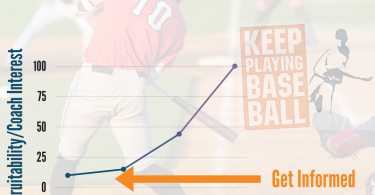A Brief Overview
College baseball scholarships are often misunderstood by the players and parents seeking them. Unlike football or basketball, which are headcount scholarship sports (every player on scholarship is on a full scholarship), baseball is an equivalency scholarship sport. That means that the vast majority of players on scholarship only have a portion of their cost of attendance paid for. For example, a player may be on a scholarship that only covers 25% of their total cost to attend school. When you add up all the scholarships on the team, the total is equivalent (equal) to the number of scholarships allowed by the institution or division.
As a result of being an equivalency sport, it’s likely you’ve heard terms like “tuition and books” or “room and board,” thrown around when people discuss scholarship offers. This can get confusing. Luckily we have free resources to help you understand your scholarship offer and compare multiple scholarship offers to see which makes the most financial sense.
As you learn about college baseball scholarships in more detail, remember that coaches have a limited amount of scholarship money each year and that the competition for scholarship money has never been more difficult. Below we discuss what you need to know about scholarships and some of the rules restricting the way scholarships can be given. We’ll start with some of the level-by-level rules and guidelines:
NCAA
Each NCAA division has its own scholarship rules and limits. These rules and limits are outlined below.
D1 Team Limit: 11.7
NCAA D1 baseball programs are allowed to offer a maximum of 11.7 athletic scholarships, which can be divided up among a maximum of 27 players. A D1 player on scholarship must receive a minimum scholarship of 25% of the total cost of attendance. A full scholarship includes tuition, fees, books, room, and board. Provisions have been added in recent years that allow programs to help with other education related expenses and assist players with Name Image and Likeness (NLI) money.
D2 Team Limit: 9
NCAA D2 baseball programs are allowed to offer a maximum of 9 athletic scholarships, which can be divided up among players however a coach sees fit. A full scholarship includes tuition, fees, books, room, and board.
D3 Team Limit: 0
NCAA D3 baseball programs offer no athletics-based financial aid or scholarships. However, many D3 schools are able to creatively package other forms of aid to greatly reduce the cost of attendance for student-athletes. Before you disqualify D3 programs on the basis that they do not offer scholarships, be sure to do your homework. There are D3 programs that are committed to meeting 100% of demonstrated financial need for students.
NAIA
NAIA Team Limit: 12
NAIA baseball programs are allowed to offer a maximum of 12 athletic scholarships, which can be divided up among players however a coach sees fit. A full scholarship includes tuition, mandatory fees, books and supplies required for courses in which the student-athlete is enrolled, and room and board based on the official allowance in the school’s catalogue.^
NJCAA
Each institution belonging to the NJCAA chooses to compete on the Division I, II or III level in designated sports.* Each level has different scholarship terms and team limits described below.
NJCAA D1 Team Limit: 24
Division I NJCAA’s may offer full athletic scholarships a maximum of tuition, fees, room and board, course related books, up to $250 in course required supplies, and transportation costs one time per academic year to and from the college by direct route.*
NJCAA D2 Team Limit: 24
Division II NJCAA’s are limited to awarding tuition, fees, course related books, and up to $250 in course required supplies.*
NJCAA D3 Team Limit: 0
Division III NJCAA institutions may provide no athletically related financial assistance. However, NJCAA colleges that do not offer athletic aid may choose to participate at the Division I or II level if they so desire.*
California Community College (CCCAA) Team Limit: 0
The cost of attendance at California community colleges is already heavily subsidized, but CCCAA baseball programs are not allowed to offer any athletic scholarships.
Other State Regulated Community College Organizations
Several other states have their own rules and regulations governing their community college system. We recommend you use the websites of each organization for the most accurate information on subsidies and scholarships.
NLI Money
Recently passed legislation allows players to benefit from their Name, Image, and Likeness (NLI) in ways that previously weren’t allowed. At the highest level of college athletics, NLI money can be very lucrative. NLI money and opportunities will be evolving, but it is worth asking whether current players are benefitting from the rule changes during the recruiting process and what type of NLI opportunities are out there.
Common Scholarship Terms
As you can see, coaches have to carefully split up their scholarship allotment. For parents and recruits, it can get confusing as to what scholarship money will and will not pay for, but here are some general guidelines:
Tuition
Often a scholarship will pay for some or all of tuition. However, tuition may change from year to year, and scholarships often stay the same. Be prepared for extra costs in case your son gets a scholarship that originally paid full tuition, but doesn’t cover it anymore after the first year or two. If your son is looking at schools out of state, find out if the coach can make it possible for you to pay “in-state” tuition for your “out-of-state” son. This is sometimes an option for coaches and even though you have to pay the tuition, it can be thousands of dollars less than the amount that out-of-state students typically pay.
Books
The amount offered to your son for books may be an arbitrary amount (for example, $500 for the year). It does not at all reflect what books will actually cost your son. It’s just meant to help. In some majors (especially the hard sciences), a single book for one class for one quarter or semester can cost $100-$200. Check in the bookstores of the schools you visit so you can get an idea of how much books might cost. If your son is offered “tuition and books,” make sure to ask specifically how much is being offered for “books.”
Room and Board
Again, the amount offered for room and board may be an arbitrary amount, loosely based around either the cost of the residence halls on campus or the housing market close to campus. Residence halls are often an expensive option for housing. That being said, your son may not want to live outside of the dorms during his freshman year because the experiences he’ll get living in the dorms are extraordinary. Off-campus housing can be more flexible in terms of cost. Keep in mind that the rent is only a part (albeit a large part) of the cost of living. Depending on the landlord, your son may also be responsible for electric, city, cable, and Internet bills. These things can add up.
Miscellaneous Expenses
College is meant to be enjoyed, and unfortunately that sometimes gets a little costly. Don’t expect your son’s scholarship to be able to pay all the bills. If possible, provide him with enough money to spend on things like going out with friends. We’re not talking extravagant amounts here, but there’s nothing worse than having to miss out on being with your friends because of an empty bank account.
Important Note: If your son qualifies for more financial aid than he would be given if he took a baseball scholarship, he might be asked to take the financial aid so that the team can take the scholarship money back to help another student (remember, the number of scholarships is limited). But at some levels, only scholarship players have guaranteed roster spots once the fall scholarships are dispersed. That means if your son is cut while on scholarship, he cannot be replaced on the spring roster and the team will have to play with one less player. Obviously, coaches must be committed to their scholarship players. So, if you are considering taking a financial aid package rather than a scholarship (and there may be some good reasons for that), be sure to talk with the coach before you make any decisions and ask if he will verbally guarantee a roster spot for your son.
It is important to be rational when it comes to a scholarship. Don’t expect your son’s scholarship to provide a free ride; think of it as an aid in paying for college. Manage the money accordingly. And don’t forget to congratulate your son. There’s a lot of hard work that’s gone into earning the remarkable reward of a scholarship.
For more help understanding scholarships, see the www.NCAA.org website. For more information on how to pay for your son’s college education, go to the FAFSA (Free Application for Federal Student Aid) website at http://www.fafsa.ed.gov/. You should always fill out a FAFSA form, even if your son has been given a scholarship, because it may help you save more money!
*From the NJCAA Website FAQs
^ From the NAIA Website







